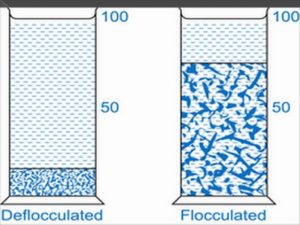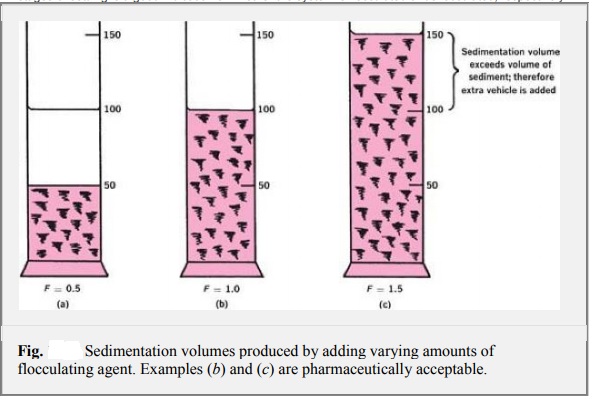Suspensions: Sedimentation of flocculated particles, sedimentation parameters and MCQs for GPAT, NIPER, Pharmacist and Drug Inspector exam
SEDIMENTATION OF FLOCCULATED PARTICLES:
When sedimentation is studied in flocculated systems, it is observed that the flocs tend to fall together, producing a distinct boundary between the sediment and the supernatant liquid. The liquid above the sediment is clear because even the small particles present in the system are associated with the flocs. Such is not the case in deflocculated suspensions having a range of particle sizes, in which, in accordance with Stokes’s law, the larger particles settle more rapidly than the smaller particles. No clear boundary is formed (unless only one size of particle is present), and the supernatant remains turbid for a considerably longer period of time. Whether the supernatant liquid is clear or turbid during the initial stages of settling is a good indication of whether the system is flocculated or deflocculated, respectively. The initial rate of settling of flocculated particles is determined by the floc size and the porosity of the aggregated mass. Subsequently, the rate depends on compaction and rearrangement processes within the sediment. The term subsidence is sometimes used to describe settling in flocculated systems.

Fig 1 – Sedimentation in flocculated and deflocculated suspension(taken from formulation and bioavailability parameters of pharmaceutical suspension innovareacademics.in)
SEDIMENTATION PARAMETERS:
Two useful parameters that can be derived from sedimentation (or, more correctly, subsidence) studies are sedimentation volume, V, or height, H, and degree of flocculation. The sedimentation volume, F, is defined as the ratio of the final, or ultimate, volume of the sediment, Vu, to the original volume of the suspension, Vo, before settling. Thus, F = Vu/ Vo
The sedimentation volume can have values ranging from less than 1 to greater than 1.
F is normally less than 1, and in this case, the ultimate volume of sediment is smaller than the original volume of suspension. If the volume of sediment in a flocculated suspension equals the original volume of suspension, then F = 1. Such a product is said to be in flocculation equilibrium and shows no clear supernatant on standing. It is therefore pharmaceutically acceptable. It is possible for F to have values greater than 1, meaning that the final volume of sediment is greater than the original suspension volume. This comes about because the network of flocs formed in the suspension is so loose and fluffy that the volume they are able to encompass is greater than the original volume of suspension. This situation is illustrated in Figure c, in which sufficient extra vehicles have been added to contain the sediment(F = 1.5).
The sedimentation volume gives only a qualitative account of flocculation . A more useful parameter for flocculation is β, the degree of flocculation. If we consider a suspension that is completely deflocculated, the ultimate volume of the sediment will be relatively small. Writing this volume as V∞, based on equation F ∞ = V∞/V o Where F = sedimentation volume of the deflocculated, or peptized, suspension.
Substituting equations β = Vu/V o V∞/V o β = Vu/ V∞¢
The degree of flocculation, β, is therefore defined as the ratio of
F to F∞, β = F/ F∞.
The degree of flocculation is a more fundamental parameter than F because it relates the volume of flocculated sediment to that in a deflocculated system. We can therefore say that β= ultimate sediment volume of flocculated suspension ultimate sediment volume of deflocculated suspension.
Multiple choice questions (MCQs)
1.The particle size in suspension is
a)less than 103nm
b)102nm
c)greater than 103
d)10 nm
2.Suspension is
a)Heterogenous
b)Coarse dispersion
c)Both a and b
d)None
3.Which suspension is more stable for a short duration of time period?
a)Deflocculated
b)Flocculated
c)Both a and b
d)None
4.In ideal suspension particle should be
a)Non dispersible
b)Re dispersed
c)Forms cake
d)Should settle down
5.Stoke’s law is related to
a)Syrup
b)Suspension
c)Emulsion
d)None
6.Which suspension have more void space?
a)Flocculated
b)Deflocculated
c)Both a and b
d)None
7.____ is a zwitter ionic surfactant
a)SLS
b)Span
c)Lecithin
d)None
8.Suspension follow ____ kinetic
a)Zero order
b)Apparent zero
c)First order
d)Second order
9.HLB value of SLS is
a)10
b)40
c)12
d)None
10.____ dosage forms are uniform dispersion of insoluble solid or immiscible liquid in liquid phase
a)Monophasic liquid
b)Biphasic liquid
c)Oral liquids
d)All of the above
11.Which of the following internal phase present in the suspension?
a)Finely divided insoluble solids
b)Immiscible liquid
c)Water
d)Oil
12.Which of the following is a heterogenous liquid dosage form?
a)Solutions
b)Suspensions
c)Syrups
d)All of the above
13.Suspensions are
a)Biphasic
b)Heterogenous
c)Thermodynamically unstable
d)All of the above
14.The fine insoluble particles in suspensions are termed as
a)Internal phase
b)Discontinuous phase
c)Dispersed phase
d)All of the above
15.All are disadvantages of suspensions, except
a)Poor dose accuracy
b)Easy to swallow
c)Slower absorption than solutions
d)Aggregate formation
Solutions:
- c) greater than 103
- c)Both a and b
- a)Deflocculated
- b)Re dispersed
- b)Suspension
- a) Flocculated
- c) Lecithin
- b)Apparent zero
- b)40
- b)Biphasic liquid
- a)Finely divided insoluble solids
- b)Suspensions
- d)All of the above
- d)All of the above
- b)Easy to swallow
References:
1. GAURAV KUMAR JAIN – THEORY & PRACTICE OF PHYSICAL PHARMACY, 1st edition 2012 Elsevier, page no. 210-219.
2. Martins Physical Pharmacy, 6th edition 2011, page no. 751-752.
List of Successful GPATINDIAN CANDIDATES
Participate in Online FREE GPAT TEST: CLICK HERE
Participate in Online FREE Pharmacist TEST: CLICK HERE
Participate in Online FREE Drug Inspector TEST: CLICK HERE
Participate in CSIR NET JRF Mock Test
